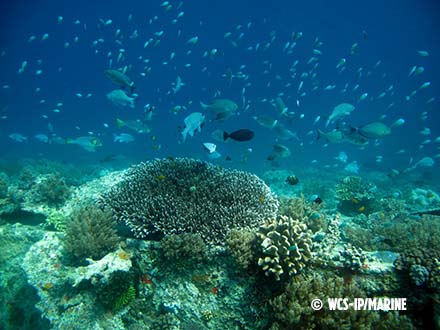
By: Stuart Campbell and Jambul
Lombok, an island located directly east of Bali in Indonesia is inhabited by 4 million people, many relying on subsistence farming and fishing for their livelihoods. About 2 hours southeast of Lombok’s new international airport, lies a coastal hideaway nestled with stretches of long sandy beaches, coral reefs, eminently reliable and inspiring surf, and local villages dotting this wild coastal environment.
It is there that a new collaborative approach involving the government, villages, WCS and the private sector is taking shape. In 2000, a New Zealand aid project came to the largest bay in Lombok, Ekas Bay, to help local communities develop sustainable improvements fisheries and a wide array of mariculture projects with local communities.
Professor Kerry Black from Waikato University in New Zealand headed the program which delivered a wide range of coastal livelihood programs that to this day provide income in a sustainable manner for the people of Ekas.
Wild captured fisheries in Lombok provide for eager domestic and international markets, yet are largely unregulated and have declined like so many other reef and pelagic fisheries globally. While working for the aid project Kerry remembers sitting atop the rugged cliffs of Ekas Bay and witnessing one of the most consistent and inspiring surf breaks he had chanced upon.
A surfer for 40 years, having first visited Bali in 1970, Kerry an internationally respected oceanographer realized this natural marine environment if managed well could provide much needed source of income for communities, and reduce or even eliminate the impacts that destructive fishing had wrought.
Kerry decided to purchase some 33 hectares of coastal land with the vision to create a sanctuary that would protect the natural wonders and wildlife on land and sea. He confides, “at the time I just thought this remote strip of coast rimmed by spectacular cliffs, beaches and surf was somewhere I could retire and surf out my days!”.
Five years later and Kerry had built upon this dream and created the only tourism resort in Ekas, “Sanctuary in Lombok”. Employing over 40 local people, Kerry and his partner Moira manage the resort whose concept and peacefulness attracts surfers from around the globe to access a variety of isolated surf breaks that suit beginners and those with the surf bug firmly implanted over the years.
Previously remote and relatively untouched, this part of the world is slowly being discovered with planned resorts from international developers in the pipeline in nearby coastal areas. Facing changes unimagined even 5 years ago, Kerry is keen to further enhance and protect the natural values of the region in the face of a wave of tourism development. “I think the time has come to start to really think about preserving large tracts of forested land with native fauna, the beaches and the habitats such as coral reefs that provide fish for the people,” he says.
The marine wilderness that communities have relied on for centuries has changed, and although it is known that some reefs have been damaged and fisheries are in decline, the existing health of the natural biodiversity including coral reefs and fisheries throughout the bay and in adjacent bays is pretty much unknown. In a first for this area, Sanctuary in Lombok and WCS held a workshop on May 22 to discuss the urgent need to cater to the growing tourism demand and couple this with well planned strategies to sustainably manage the area’s natural resources.
The workshop was enthusiastically attended by over 40 people including department heads from fisheries, tourism and planning agencies, the police and military and village representatives from the districts of East and Central Lombok. The meeting discussed the future management of Ekas Bay and it surrounds.
A significant outcome of the meeting was an agreement by all present to build a reef in an area devoid of reef due to past destructive practices and natural processes. In 2011 Kerry supervised a Masters student who built a 3x3 m and 2m high reef from natural limestone, and two years later the reef has been biologically adorned with a diversity of corals that have become habitat for more than 50 species of reef fishes and countless invertebrates. Local fishers each morning in small motorized boats benefit from the small boost in fish stock that spillover from the reef.
Kerry says, “Our concept is to attract international visitors and donors to help build a series of sea gardens in areas that are naturally suited to coral reef development. The reefs have struggled to return due to the lack of suitable reef bottom so we are simply adding natural rock in a 3 dimensional structure, that we have demonstrated acts as a natural base for corals and fisheries to recruit to”.
Once built the communities become the local stewards of the reefs using local “awig awig” customary laws to determine how they can be used. In return, the communities are willing to cease fishing on nearby vibrant natural reefs, fish the edges of these natural habitats using non-destructive fishing gears and enforce the banning of destructive fishing.
The “sea garden” concept will also act as a natural nearshore classroom that can be used by schools to educate on marine ecology and issues relating to the marine environment, and serve as an education tool for tourists who may wish to assist communities build more reefs in the future in suitable areas.